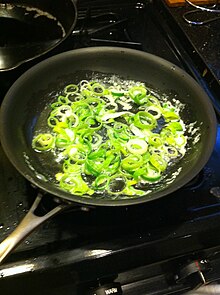Sauté
Sautéing ( French for “jumping”) is a special form of quick frying .
To do this, fry the thinly sliced or shredded food, e.g. B. shredded meat , fish , vegetables or mushrooms , at a high temperature of approx. 160 to 240 ° C open in a pan with a raised rim ( sauté pan ). Only enough is put into the greased pan that everything can lie next to each other and the food quickly absorbs the heat. The food is turned over by continuously swiveling the dishes. Liquid is not added.
Because of the high temperature when sautéing, butter is not recommended; clarified butter or oils with a high smoke point (such as peanut or vegetable oil ) are common.
meat and fish
It was assumed that the rapid searing would close the surface of the meat, thus preventing the juice from escaping and the meat from drying out. However, this has now been refuted by molecular gastronomy . Instead, overheating causes the meat to "stiffen" and thus become tougher. Due to the short cooking time and high temperature, however, good browning can be achieved while at the same time protecting the inner part, provided that it is protected from the spreading heat by pre-cooling and then rapid cooling to safe temperatures.
The cooks argue about whether the meat is better salted and seasoned before or after searing. The fact is that the osmotic effect of salt on meat does not happen so quickly that it can make a palpable difference whether it is salted immediately before or after roasting. However, we do not recommend salting the food for a long time before roasting.
vegetables
Also called sautéing is the swirling of cooked vegetables with butter , cream and the like. a. This creates a certain bond and the vegetables are glazed .
Web links
Individual evidence
- ^ E. Pauli: Textbook of the kitchen. Pauli Fachbuchverlag, 2005, ISBN 3-9523024-0-6 .
- ↑ Right ?: Legendary juice brake. In: time online. November 23, 2000.
- ↑ Meat: Salt before or after roasting?
